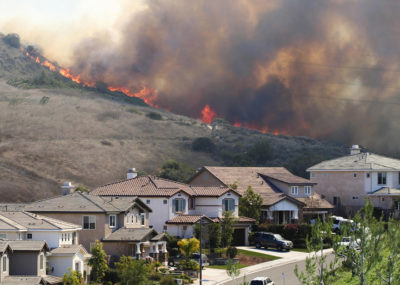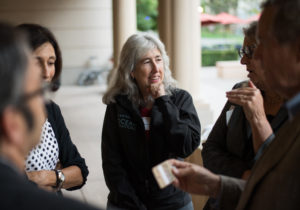Living with Fires: Stanford’s Deborah Sivas on Mitigating Risks with Law and Environmental Policy

With fire season just beginning, already thousands of separate fires have scorched more than 1 million acres across California—and two of the largest fires on record are still burning. As smoke covers the Bay Area, these fires are, once again, touching population centers including the commuter city of Vacaville just 35 miles from Sacramento and 55 miles from San Francisco, where structures burned in one of the August “lightning fires” raging across the Bay Area. Here, Stanford Law Professor Deborah Sivas, director of Stanford’s Environmental Law Clinic and Environmental and Natural Resources Law & Policy Program, discusses the effects of climate on fires in the state and policy changes that might lessen their danger to residents.
Is climate change leading to more fires in California? Or is forest management part of the problem? President Trump has suggested the need for more raking of the forests’ floors.
Wildfires in California is a complicated issue and, unfortunately, not subject to simple solutions. First and foremost, the ignition and spread of wildfires is largely dependent on climate. To the extent that we are experiencing more frequent or more intense wildfires, climate change is clearly playing a significant role. As temperatures rise and periodic droughts become more frequent, the models predict that wildfires will become more intense and potentially more destructive. This year, for instance, the northern half of California experienced lower winter rainfall than average, meaning that vegetation dried out earlier and is more at risk of wildfire.
Of course, California is no stranger to wildfire and our native habitats have evolved in a dry summer-fall fire regime. But human alteration of the natural regime has increased the risk and destructive power of wildfires. In talking about risks and policy prescriptions, we need to separate out wildfires at the wildland-urban interface—those that put people and communities at most risk—from fires that historically have burned through our remote forestlands. The President’s “raking the forest” suggestion doesn’t meaningfully address either situation, unfortunately.

Regarding policy, what could California do to decrease the number and severity of fires in those wildland-urban interface areas?
Fires at the urban edge are the ones we need to be most concerned about because of the potential for loss of life and property. In California, we have roughly five million at-risk homes sitting at the wildland-urban Interface, including many in the increasingly flammable chaparral shrublands of Southern California. We need to be much more serious about policies designed to reduce risk through, for example, better building codes and landscaping requirements. Studies show that much of the damage suffered in these areas is linked to structural design and materials, vegetation (especially non-native vegetation like eucalyptus trees) too close to buildings, and the vulnerability of other accessories like propone tanks. There are now model ordinances out there that set forth best practices for roofing, exterior walls and decking, vents, defensible space/vegetation management requirements, and the like. As a society, we should be much more intentional about how to implement these practices.
And what about mitigation efforts in our vast forests?
Forestlands present a different set of policy challenges. California’s native forests evolved with, and are maintained by, a natural fire regime. A century of human fire suppression has altered the landscape to some extent, and some scientists believe that controlled burns or selective thinning of vegetative understories would be beneficial for reducing the risk of catastrophic fires.
I understand that Native tribes have been consulting with state fire agencies on fire management. Is there something we could learn from the people who have lived here longest?
Yes, absolutely. As I mentioned, the notion of controlled burns as a way to try and reestablish the natural fire regime is very sensible. This is something that was and is practiced by Native people. Low intensity burns can rid the forest floor of smaller vegetation which accumulates in a fire suppression regime without harming the large, older trees that keep the forest fire- resistant.
The main obstacles for forests near urban communities are the worry about controlled burns getting out of control and about localized smoke impacts. These concerns can be significantly mitigated through careful planning consistent with weather conditions. And lower levels of smoke associated with occasional controlled burns are ultimately preferable to what we are all experiencing this week.
What about logging as a tool to help thin forests?
The science is also pretty clear that forestlands that have been traditionally logged are not less prone to wildfire. Indeed, the contrary may well be true. Even where timber sales are justified as “fuels management” treatments, logging companies inevitably remove many of the oldest, largest trees because those are the ones with market value. But these big, old trees are the most fire resistant and provide the most shade and cooling; their removal causes the forest floor to dry out and can actually facilitate more intense fires. For instance, the Camp Fire in 2018, which essentially destroyed the town of Paradise, California, roared through heavily-logged public and private forestland before arriving at the town.
Do we have enough resources to manage our forests? The August fires in the Bay Area seemed to burn without much intervention until they grew—and fire officials were open about a resource issue.
Here, again, the difference between the urban edge and other remote wildfires is important. The most important situation to address is uncontrolled wildfires at the wildland-urban interface, where lives and property are threatened. From last week’s lightning storm, which sparked numerous fires in or near populated areas, it seems clear that our firefighting resources can be strained by what was a rare event or convergence of events.
But I’m not convinced that 50 new aircraft to drop buckets of water is the solution. A better investment may well be to concentrate public resources on things like controlled burns and vegetation management at the urban edge and in the wildland-urban intermix (where structures are interwoven with wildland fuels), with the goal of reducing the intensity and spread of these inevitable wildfires—most of which, by the way, are started by human activity, not electrical storms. Rather than having to battle huge conflagrations after they get going, at-risk communities would be better-served by well-designed and implemented preventive measures.
Unfortunately, we really don’t have the right combination of public and private incentives and regulations—carrots and sticks, if you will—in place. We are geared up to fight wildfires like we fight wars, with heavy machinery and manpower (including prison labor that is in short supply this year due to the coronavirus). As it becomes harder and harder to procure adequate fire insurance, maybe we will start to see more public outcry for risk-reduction strategies.
Has rainfall been a big problem this year?
Winter rainfall was actually below average in the northern part of the state—only about 50 percent of normal in the Bay Area. But many parts of Southern California received average or greater-than-average rainfall this year. Yet the massive Apple Fire burned thousands of acres in Riverside and San Bernardino counties. And we are not yet into the true fall fire season that typically afflicts Southern California when the Santa Ana winds kick up in October. So rainfall is an important factor, but not the only one.
Are there more fires in California?
I don’t know whether the data actually show that we are getting more or earlier fire starts on a long-term trajectory, but the California fire season is becoming more unpredictable as climate conditions change. Last week, we saw a very rare summer electrical weather system rolling in from the south at precisely the moment that Northern California was experiencing a heat wave and coming off a winter rainfall deficit, which set up a perfect storm. I don’t think scientists are able to say that any one of these events or factors is due to climate change, but the increase in atmospheric greenhouse gases may be exerting pressure on each of them such that conditions are becoming more unstable and the convergence of factors becoming likelier.
Deborah A. Sivas is the Luke W. Cole Professor of Environmental Law at Stanford, the director its Environmental Law Clinic, director of its Environmental and Natural Resources Law and Policy Program, and a senior fellow at the Stanford Woods Institute for the Environment.
